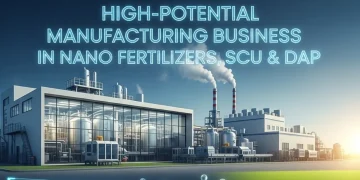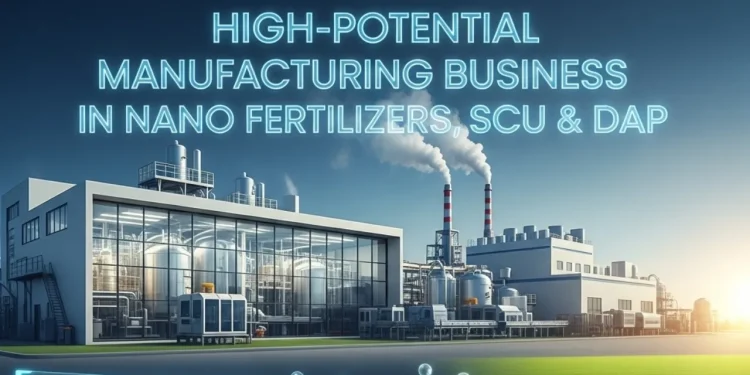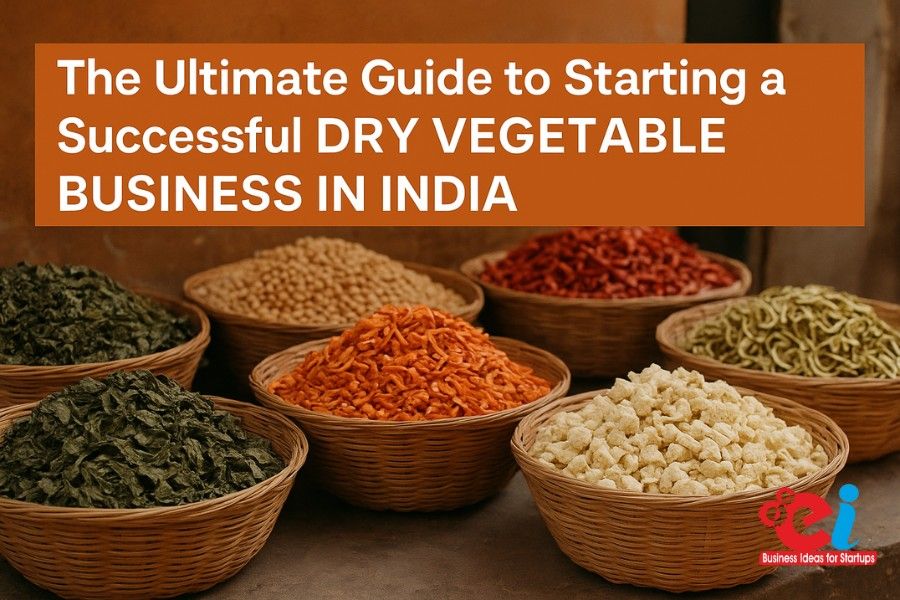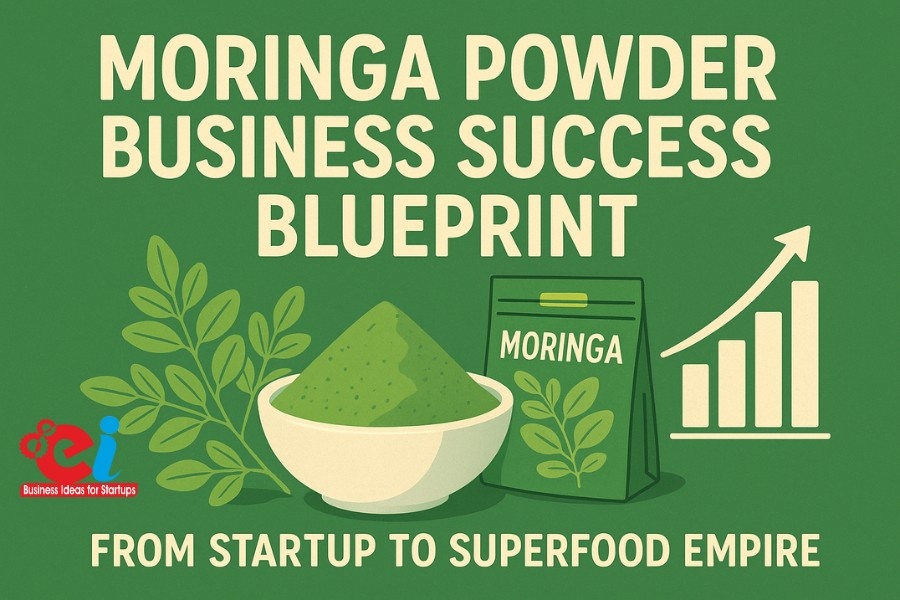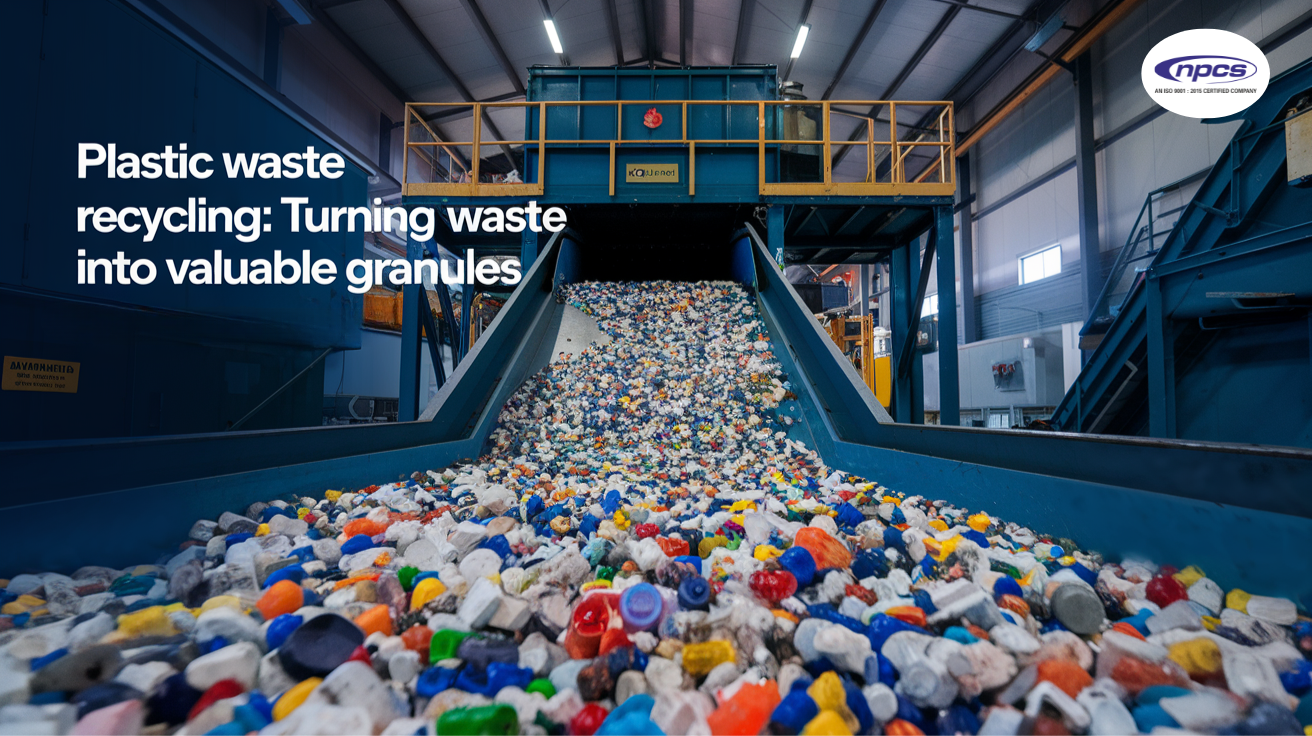High Potential Manufacturing: The most visible shift has occurred in the fertilizer industry in India. According to Government estimates for FY 2023-24, the production of urea stands at 314.09 LMT.
At this level, government aims to promote the use of DAP and other new novel high-efficiency fertilizers, like Nano Fertilizers and Sulfur-Coated Urea, is beginning to pay off. The advances in the industry boast of greater sophistication in technology-based fertilizers.
The import of fertilizers like DAP and MOP which amount to 176.95 LMT along with the import of other raw materials like broken rock phosphate, have also been captured in the 2023-24 annual report of the Department of Fertilizers.
This does not leave much for the developing fertilizer industry to counter in opposing the vigorous energized affiliated with the emerging start-up ecosystem, in particular, import substitution and the innovative exports of novel fertilizers being developed.
Read Our Project Report: Click Here
Enhance Market Potential-High Potential Manufacturing
The emerging growth from 2020-2022 has been consolidated with the sectors of Nano Fertilizers and DAP. The continuous production of Urea Gold SCU reached new highs at 4,675 MT by July 2024 while Nano Urea also produced 1,015.28 Lakh bottles during the same period, marking a record in production.
Due to the national the current utilization and application of DAP fertilizers and the aptly 55.67 LMT imported and 42.97 LMT produced domestically provides the reason needed to open the market.
It is clear that the MDA, MDA, MDA, and the MDA is ready to provide sustenance to the market as the MDA, MDA, PMKSK and the Namo Drone Didi sponsored systems understand the importance of market development. This shows that the market is indeed fluid and conditions are ripe for the emergence of new enterprises.
Why Are These Sectors the Best Fit for New Entrepreneurs
Nano DAP and Nano urea are classified as FCOs and therefore the complicated and time consuming government red tape for product sanctioning is lifted to some degree. This enables the ever increasing demand for the FCO DAPs and the exorbitantly priced fertilizers in India to be tapped.
The Nano DAP which India fulfills, undergoes, net plus coated hybrid and organic fertilizers in India and the Foreign Trade Balance and the Soil Health and Sanitary Acts.
Indian entrepreneurs are strategically positioned along with guaranteed purchasers and an ever-positive outlook due to the bilateral agreements made with Nepal, Bhutan, and Sri Lanka pertaining to the Memorandum of Understanding regarding the direct export of advanced fertilizers.
Consequently, this helps to foster the mobility of an ever-growing enterprise.
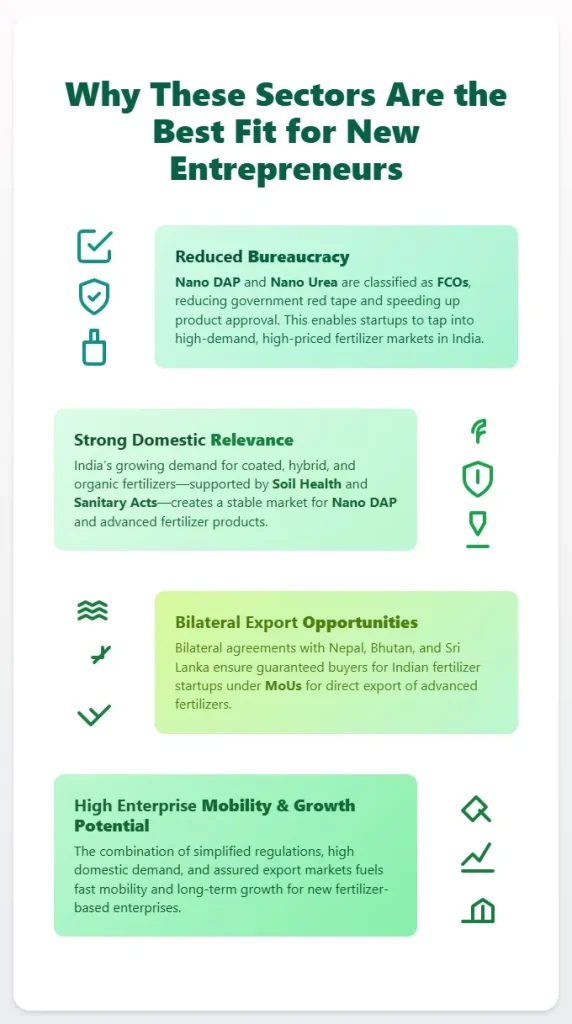
Manufacturing Ventures-High Potential Manufacturing
The argumentation supporting the simplest business outlined below has led to the emergence of three distinct sectors within the entire economy.
Nano Fertilizers
With the advantage of reducing waste, the Nano-scale fertilizer puzzle fillers enhance the uptake of crops. India today has six Nano Urea plants, and currently has an aggregate capacity of 27.62 crore bottles of Nano Urea, with a target of 5 more plants by 2025. In addition, India has 4 functional Nano DAP units and 2 that are currently under construction.
The transport costs are significantly lower with nano fillers packaged in bottles compared to the traditional heavy sacks. For example, a 46 kg Urea bag can be replaced with a 500 ml bottle of nano urea. Consequently, new entrants in the field can consider small-scale units capable of contract manufacturing for PSUs and other novel approaches of delivering nano fertilizers.
For instance, the Nano DAP micro unit located in the State of Rajasthan operates with the use of NPCS in which the founders are capable of planning the engagement of remote sales with the layout of the capacity equipment, field applications of nano fertilizers by drones, and the use of PMKSK systems.
Urea Gold or SCU, is a unit that has a steep price but is still underused.
The Urea Gold produced by RCF, Up to this date showed enhanced ratio of nitrogen compared to ratio of land used and the the soil. SCU promotional activities Registered SCU status is SCU promotional activities Registered SCU status. Therefore, the market is SCU promotional activities Registered SCU status.
The SCU that improves the soil and yield is brought positive set by price. All other SCU and R&D units or forebear advanced SCU pack. Offer additional Government Units for offered energy SCU further to their energy units-High Potential Manufacturing.
The units energy-efficiency SCU. Through the cane growers and marketers and SCU FPOs can cotton. Not with standing to construct coating next Gujrat and SCU Urea production facility.
Read Our Book: Click Here
DAP Manufacturing and Importing: Unmet Demand
In quantitative terms DAP is the second biggest fertilizer import after Urea. In 2023-2024 Balance India is estimated to produce 42.97 LMT and import 55.67 LMT DAP resulting in a negative Balance of Supply of LMT. DAP importers and the domestic market for blending and processing DAP have been set for some time now.
Startups are in a position to set up DAP blending plants working with imported DAP intermediates and local rock phosphate and phosphate-rich organic blends and domestic rock phosphate processes with imported and local organic blends DAP orthodox substitutes local blending. In support of domestic production, soaring global price for DAP has created significant export potential to Bhutan and Nepal-High Potential Manufacturing.
Relocate the plants and ports to ease docking the unit for import of phosphoric acid and the blended unit. This augments the value of NPCS’s support in connecting the agricultural belts of middle India to the DAP blending and downstream export configuration to South Asia. Initially, the planned entrepreneurs are expected to build South Asia export capable mid- unit DAP blending in the center.
Trade Outlines
India s tate receives 90% of rock phosphate, gas, phosphoric acid, and ammonia which are vital for facilitation manufacturing processes.
To sustain this trade, the country exports DAP and urea fertilizers to neighboring territories and supplied 20,000 MT of DAP and 44,000 MT of Urea to Nepal in 2023, while Bhutan is asking for 5,000 MT/year.
There dowever exists domestic demand for substitutable Nano Fertilizers and the SCUs imports which on the contrary supports exports, while the export MoUs support the starts to export these products. Provisions exist for the addition of imported raw materials to high-value-added fertilizers, but only to an extent.
Read More: Startup Opportunity in Soil Health
Government Support and Future Initiatives-High Potential Manufacturing
In the current scenario, India is trying to set up 11 new units for Nano Fertilizers by 2025 in addition to the new production coming from the revived urea plants in Sindri, Barauni and Ramagundam. “Fertilisers” of organic origin are being sold under the MDA programme at a subsidised, tiered rate of ` 1500/MT.
Advisory services are provided at 2.14 lakh PMKSK outlets which are currently functioning as the first points of distribution. For this purpose, the Namo Drone Didi program envisions training 15,000 women on drone sprayers. Together, these programs are expected to augment employment in manufacturing, logistics, and packaging, as well as in the training and spraying services.
Case Studies of Best Practices and Their Key Contributors-High Potential Manufacturing
They also look at the role of IFFCO in bulk production and commercialization of nano urea and their auxiliary services and how this impacts the economy.
Jones (2022) describes the decision of IFFCO and Indian Farmers’ Fertiliser Co-Operative (IFFCO) in bulk production and commercialization of nano urea and their ancillary services as a breakthrough to embrace new inputs and expand cultivation.
Even the RCF found these rather restricted economic contexts difficult to evolve new and better urea products (golden urea). FAGMIL has accomplished the industrial advancement by installing the first SSP plants in Sri Lanka.
The partnership with farmers’ cooperatives would certainly be beneath these models with the new product to the developed foreign markets and the expansion of the foreign market.
Read More: High-Potential Manufacturing Businesses in Nano Fertilizers, SCU & DAP
Unique Business Models for Potential Entrepreneurs-High Potential Manufacturing
Model 1: Drone Services for Nano Fertilizer
Integrate production of nano fertilizers with drone services for seamless and efficient spraying.
Model 2: SCU Units Near Sulfur Sources-High Potential Manufacturing
Stray refinery sulfur and adjoining refinery SCU coating plants near urea plants.
Model 3: Competent DAP Blending with Export-High Potential Manufacturing
Blend surplus DAP intermediate and export it to Nepal or Bhutan-High Potential Manufacturing.
Model 4: PMKSK Franchise-High Potential Manufacturing
Franchise of nano, SCU, and organic fertilizers with soil consultation and testing services.
Model 5: Fertilizer From Waste-High Potential Manufacturing
Biogas from anaerobic digesters using SATAT. Targeting municipal and agri bio-waste.
Action Plan for Founders-High Potential Manufacturing
Choose one product line: Nano, SCU or DAP.
- Complete the form for the subsidiary fund grant competition.
- Define the tactics for the acquisition of the mandatory raw materials.
- Raise the needed finances based on the NPCS’s DPR.
- Increase the development of PMKSK and the other digital distribution channels.
- Use drones and other digital technologies.
Start exports to South Asia-High Potential Manufacturing.
Final Thoughts: The Future is Beyond Urea-High Potential Manufacturing
Currently, in India, the advancement of fertilizers is focusing on the efficient, environment-friendly, and imaginative progress of Urea. South Asia’s fertilizers industry holds great potential to capitalize on the next waves of cutting edge advanced manufacturing and technology in Nano fertilizers, SCU and DAP.-High Potential Manufacturing
Area start-ups may pursue profitable and eco-friendly green business models with enhanced profitability and yield, provided policies support them, as they will have a huge market internally and prospects for exports.
NPCS, in this manner, reduces risk and opens up a market for entrepreneurs in productive agriculture within India.
How NPCS Can Help You-High Potential Manufacturing
NPCS assists clients in developing Market Survey cum Techno Economic Reports and DPR Reports and walks them through the entire tech packs-manufacturing cycle. This includes product and demand documentation, essential raw materials and resources, process flow charts, and projected cash flow objectives.
NPCS assists new entrepreneurs in the fertilizer industry in setting and redefining new business parameters and assessing industry profitability and growth.
FAQs-High Potential Manufacturing
1) Current fertilizers still exhibit innovative business opportunities. What are they?
Nano Fertilizers, SCU (Urea Gold) and DAP.
2) Why is DAP considered business the aqua sector?
The reason being, the domestic production is on huge back foot compared to the internal demand.
3) Why are nano fertilizers considered different?
Nano fertilizers improve profit margins as they increase the uptake of fertilizer, thereby reducing transport and storage costs.
4) What flagship programs are considered to boost the business of DAP fertilizers?
PMKSK, MDA, and Namo Drone Didi are the flagship programs considered to boost the business of DAP fertilizers?
5) Is there a demand for exports among foreign countries?
Certainly, there is. India disappears sells to Nepalis and BhuIcan and later aims at several more markets.
